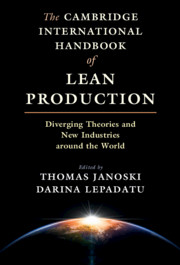 The Cambridge International Handbook of Lean Production
The Cambridge International Handbook of Lean Production Book contents
- The Cambridge International Handbook of Lean Production
- The Cambridge International Handbook of Lean Production
- Copyright page
- Dedication
- Contents
- Tables
- Figures and Sidebars
- Preface
- Acknowledgments
- Contributors
- Abbreviations
- 1 Lean Production as the Dominant Division of Labor
- Part I Theories of Lean Production
- Part II Lean Production across Industries
- Part III Lean Production Around the World
- 17 Lean in Europe and the USA – A New Dominant Division of Labour?
- 18 The Development and Diffusion of the Hyundai Production System
- 19 Transferring Lean to the United States
- 20 Disseminating Lean across the UK: A Personal Reflection
- 21 Lean Production in Germany
- 22 Tricolore
- 23 Lean Production in China: A Case Study of the Automobile Industry
- 24 Lean Production in India and Australia
- 25 The Four Stages of Lean in Mexico
- 26 Lean Production in Post-Communist Europe
- Name Index
- Subject Index
- References
23 - Lean Production in China: A Case Study of the Automobile Industry
from Part III - Lean Production Around the World
Published online by Cambridge University Press: 11 March 2021
- The Cambridge International Handbook of Lean Production
- The Cambridge International Handbook of Lean Production
- Copyright page
- Dedication
- Contents
- Tables
- Figures and Sidebars
- Preface
- Acknowledgments
- Contributors
- Abbreviations
- 1 Lean Production as the Dominant Division of Labor
- Part I Theories of Lean Production
- Part II Lean Production across Industries
- Part III Lean Production Around the World
- 17 Lean in Europe and the USA – A New Dominant Division of Labour?
- 18 The Development and Diffusion of the Hyundai Production System
- 19 Transferring Lean to the United States
- 20 Disseminating Lean across the UK: A Personal Reflection
- 21 Lean Production in Germany
- 22 Tricolore
- 23 Lean Production in China: A Case Study of the Automobile Industry
- 24 Lean Production in India and Australia
- 25 The Four Stages of Lean in Mexico
- 26 Lean Production in Post-Communist Europe
- Name Index
- Subject Index
- References
Summary
Since the 1980s the concept of “lean production” has attracted much attention and sparked off considerable debate among social scientists on work and workplace restructuring. On the one hand, the MIT researchers, who coined and popularized the term lean production, have vaunted lean production as representing a fundamental, progressive break with Taylorism and Fordism that will lead to a more fulfilling workplace and empower workers (Womack, et al. 1990). On the other hand, critics have contended that rather than representing a qualitative break with the Fordist regime, lean production is essentially a modified form of Taylorism and Fordism (albeit leaner and more flexible) because assembly line, standardization, volume production, and capacity utilization remain central to the lean production paradigm (Berggren 1993; Babson 1995: 14; Price 1995). Ethnographic studies of the impact of lean on workers cast a more skeptical view on the “empowerment” claim, as researchers find lean production is often associated with the intensification of work and greater managerial control, without real empowerment of workers (Graham 1995; Parker and Slaughter 1995; Mehri 2005, 2006). With respect to its implementation, contrary to the claim of MIT researchers that the principles of lean production are “applicable anywhere by anyone” (Womack et al. 1990: 7), cross-national comparisons have shown wide variations as well as limits in the adoption of lean production in different national and local contexts (Kochan et al. 1997; Jürgens and Krzywdzinski 2016). While there has been growing interest in the spread and implementation of lean production in China, most of the existing literature has focused on the problems and effectiveness in implementing lean production by Chinese manufacturers from the perspectives of management and business consultancy (see, among others, Taj 2008; Chen and Meng 2010). To date we know relatively little about how lean production has affected the workplace and workers in the Chinese context.1
- Type
- Chapter
- Information
- The Cambridge International Handbook of Lean ProductionDiverging Theories and New Industries around the World, pp. 549 - 572Publisher: Cambridge University PressPrint publication year: 2021


